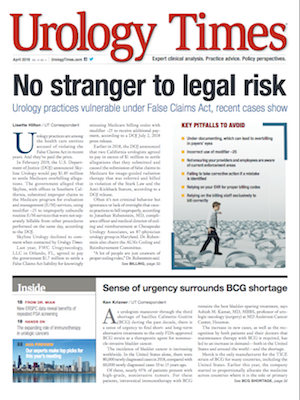Publication
Article
Urology Times Journal
Why you should resist the urge to sell in a down market
Author(s):
"When markets are down significantly, investors commonly feel a sense of panic or fear they are losing everything they have accumulated," writes Jeff Witz, CFP.
My account really fluctuated during the last 3 months of 2018. Should I have been more proactive about protecting my investments from losses?
The fourth quarter of 2018 did not reward equity investors. The S&P 500 (Large Cap Index) was down 13.52%, the Russell 2000 (Small Cap Index) was down 20.20%, and the MSCI EAFE (International Index) was down 12.54%.1
When markets are down significantly, investors commonly feel a sense of panic or fear they are losing everything they have accumulated. They obsess over the financial news and are tempted to sell to preserve what is left. However, these moves typically provide short-term comfort at the expense of long-term goals.
Selling after the markets are down may significantly reduce your ability to make up those losses in the rallies that historically occur after a sharp decline. For example, after the 2008-’09 financial crisis, in which the S&P 500 was down as much as 51%, the following rally lasted 118 months and was up over 300%.2 Following the dot-com crash in 2000, when stocks were down 45%, the following rally lasted 61 months and was up over 100%.2 In fact, every sustained down market has been followed by a significant and sustained upward rally.2
Also by Jeff Witz, CFP: How to make sense of the IRA aggregation rule
Benefiting from these rallies requires being invested in the market. If you sold previously, you may miss out on all or a significant portion of the rally. You may be thinking, “But what if I sold when things started going down and then bought back in at the bottom?” Timing the market is incredibly difficult to do. How will you know when the market is headed for a sustained downward slide, and how will you know when the market has reached bottom? These are nearly impossible things to predict, and guessing wrong can negatively impact your investment success.
Surviving a down market requires some key behaviors: faith, patience, and discipline. You need to have faith that markets will turn and, over the long term, move in an overall positive direction. Patience means not chasing the hottest trends and trusting that your investment strategy will produce the results you desire long term. Discipline means continuing to adhere to an asset allocation strategy and diversified investment mix that can help you reach your financial goals.
Next: How big of an impact can selling when the markets are going down and buying back in have on my account balance?How big of an impact can selling when the markets are going down and buying back in have on my account balance?
If we look at an example from the 2008-’09 financial crisis, we see that selling and then guessing when to get back in the market had a negative effect. Assume someone with a $1 million diversified portfolio panicked and sold in March of 2009, at the bottom of the market crash. After the markets started recovering, they bought back in after 3 months with the same portfolio. Today, their account would be worth approximately $2.64 million.3 If they had waited a full year to get back into the market, their account value today would be only $2.20 million.4
Read - Flexible spending vs. health savings accounts: How to choose
But if they had stayed invested throughout, their account today would be worth $3.28 million.4 Panicking and selling, then trying to guess when to get back in the market, is not something most investors are regularly successful at.
References
1. Morningstar Dec. 31, 2018 data. All indices referenced are unmanaged indices of various asset classes within the investment markets. None are available for direct investment.
2. S&P data copyright 2018 S&P Dow Jones Indices LLC, a division of S&P Global. All rights reserved.
3. Dimensional Funds. Benchmarks used in calculation; S&P 500 (30%), Russell 2000 (20%), Dow Jones Select REIT (10%), MSCI EAFE (18%), Barclays US Agg Bond (12%), Barclays Global Agg Bond (7%), Cash (3%).S&P data are provided by Standard & Poor's Index Services Group; Russell data © Russell Investment Group 1995-2019, all rights reserved; Dow Jones data by Dow Jones Indexes; Barclays indices © Bloomberg Barclays 2019; MSCI data © MSCI 2019, all rights reserved. Referenced indices are not available for direct investment. This is a hypothetical illustration only, and its performance is not indicative of any particular investment. Investments with potential for higher returns carry greater risk of loss.
4. S&P data provided by Standard & Poor's Index Services Group; Russell data © Russell Investment Group 1995-2019, all rights reserved; Dow Jones data provided by Dow Jones Indexes; Barclays indices © Bloomberg Barclays 2019; MSCI data © MSCI 2019, all rights reserved.
Mr. Witz is educational program director at MEDIQUS Asset Advisors, Inc. in Chicago. He welcome readers’ questions and can be reached at 800-883-8555 or witz@mediqus.com.
The information in this column is designed to be authoritative. The publisher is not engaged in rendering legal, investment, or tax advice.




















